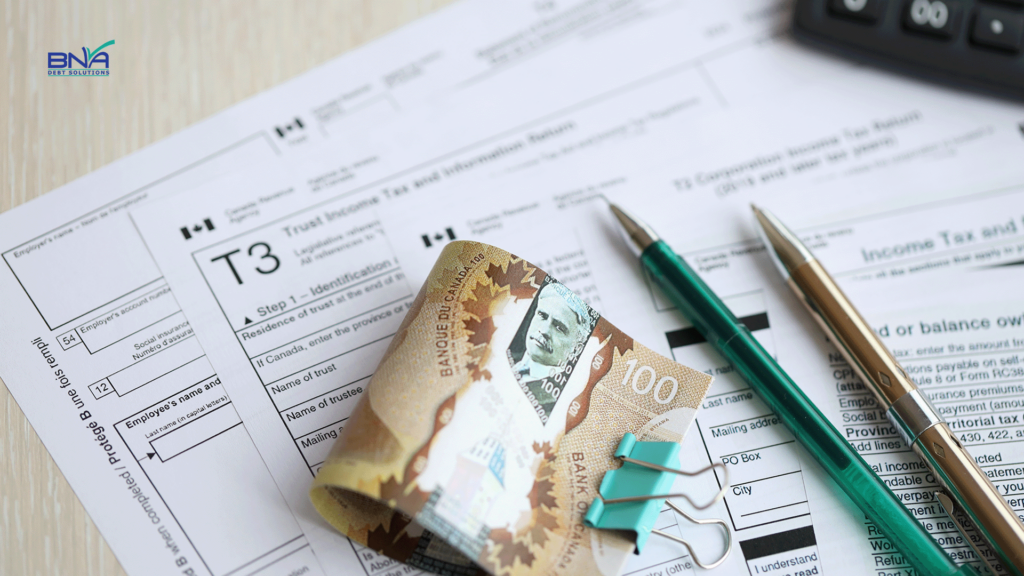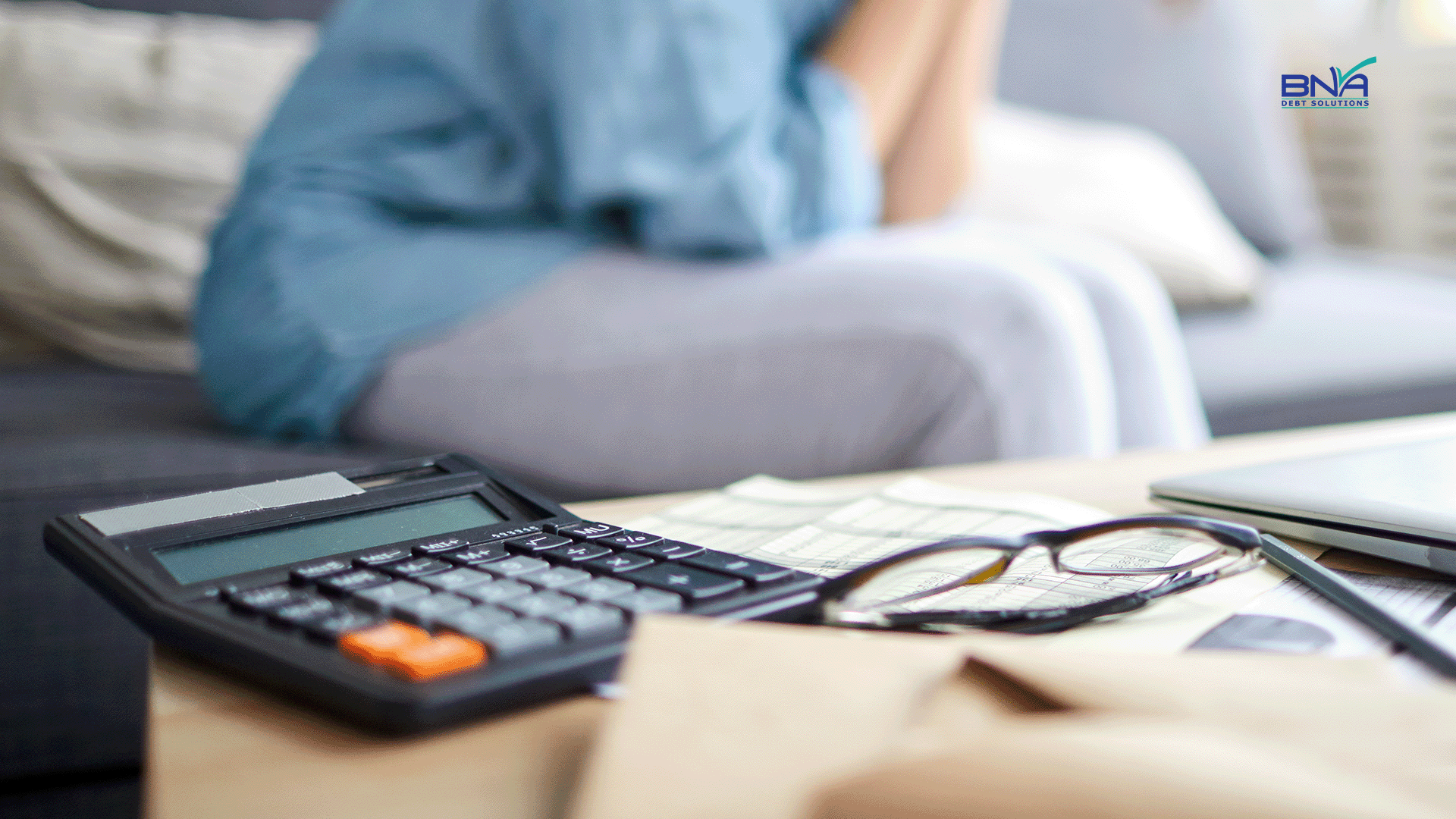Tax season is here, and if you’ve recently filed for personal bankruptcy, you probably have questions. Will the CRA contact you? What happens to refunds? Do you still need to file and pay your taxes? Don’t worry—we’ve got you covered.
Filing taxes after bankruptcy is simpler than it seems and a key step in rebuilding your finances. Even if you can’t pay right away, filing on time keeps you in control and prevents additional stress.
At BNA Debt Solutions, we make the process simple and stress-free. Our Licensed Insolvency Trustees (LITs) will guide you every step of the way—so you’re never navigating it alone. Let’s go over what you need to know to file properly and avoid any roadblocks.

What are the differences between Prior-Bankruptcy, Post-Bankruptcy and Subsequent Year Tax Returns: Everything You Need to Know
About the Prior-Bankruptcy Tax Return
If you haven’t filed your tax return for the year before your bankruptcy, you may need to file it yourself—but don’t stress. In some cases, your Licensed Insolvency Trustee (LIT) may handle it if it remains unfiled. However, you are still responsible for providing all necessary tax documents, including receipts for childcare, medical expenses, and applicable forms such as T2125, T2202, T2091, and T776, to ensure everything is processed correctly.
- What It Covers: The income you earned in the year(s) before filing for bankruptcy.
- Who Files It? If your tax return is unfiled, your LIT may handle it, but you must submit all required tax documents for proper processing.
- What Happens to Taxes Owed? These are included in your bankruptcy estate—you won’t have to pay them.
- What Happens to Tax Refunds? Any tax refunds for this period, as well as for prior year(s), go to the LIT to distribute among your creditors.
About the Pre-Bankruptcy Tax Return
A Pre-Bankruptcy tax return is for January 1st of the year in which you file for bankruptcy, up to and including the date before your date of bankruptcy. i.e. if you file for bankruptcy on June 30, 2025, your 2025 Pre-Bankruptcy tax return would cover the period of January 1, 2025 – June 29, 2025. Your Licensed Insolvency Trustee (LIT) is legally required to file this return by the Bankruptcy and Insolvency Act. However, you are still responsible for providing all necessary tax documents, including receipts for childcare, medical expenses, and applicable forms such as T2125, T2202, T2091, and T776, to ensure everything is processed correctly.
- What It Covers: The income you earned before filing for bankruptcy, in the year of bankruptcy.
- Who Files It? Your LIT.
- What Happens to Taxes Owed? These are included in your bankruptcy estate—you won’t have to pay them.
- What Happens to Tax Refunds? Any tax refunds for this period, go to the LIT to distribute among your creditors.
About the Post-Bankruptcy Tax Return
A Post-Bankruptcy tax return is for the period of your date of bankruptcy to December 31st of the year in which you file for bankruptcy. i.e. if you file for bankruptcy on June 30, 2025, your 2025 Post-Bankruptcy tax return would cover the period of June 30, 2025 – December 31, 2025.
- What It Covers: The income you earned after filing for bankruptcy, in the year of bankruptcy—this is your post-bankruptcy income tax.
- Who Files It? If you are self-employed, you are responsible for filing this return. If you are not self-employed, your LIT will likely handle it, but you must submit all required tax documents for proper processing.
- What Happens to Taxes Owed? These become your unsecured debts, which you are responsible for paying.
- What Happens to Tax Refunds? Any tax refunds for this period go to the LIT to distribute among your creditors.
About the Subsequent Year’s Tax Return
A subsequent year’s tax return is for the years following your year of bankruptcy, i.e. if you file for bankruptcy in 2025, your 2026 tax return would be considered a subsequent year’s return.
- What It Covers: The income you earned in the years after filing for bankruptcy.
- Who Files It? You are responsible to file this return.
- What Happens to Taxes Owed? These are your responsibility to pay.
- What Happens to Tax Refunds? If you are still in bankruptcy, refunds should be sent directly to you. However, if you are non-compliant with your bankruptcy duties, then CRA may send your refund to your LIT.
How to File a Post-Bankruptcy Tax Return – Self-Employed
Once your bankruptcy is underway, it’s time to submit your post-bankruptcy tax return, which you are responsible for filing if you are self-employed. This return covers the period following your bankruptcy filing to the end of the calendar year in which you filed.
Here’s something important to keep in mind: any taxes owed during this period are considered “after-acquired debts,” which means they are your responsibility. This differs from the pre-bankruptcy tax return, where unpaid taxes are included in your bankruptcy. We know it can sound overwhelming, but don’t worry—we’ll break it all down for you so it feels manageable.
Here’s what you’ll need to do:
- Create a New Tax Return: Start by creating a new tax return for the portion of the calendar year following your bankruptcy filing date.
- Enter the Bankruptcy Date: On the Bankruptcy worksheet, enter the date your bankruptcy was filed. This determines the pre- and post-bankruptcy periods.
- Select “Post-Bankruptcy ” as the Return Type: Indicate that you are filing a post-bankruptcy return, which will separate your tax obligations before and after your bankruptcy filing.
- Enter Income and Deductions: Report only the income earned and deductions applicable to the post-bankruptcy period.
- Copy Applicable Amounts: Copy the relevant amounts from your LIT-prepared pre-bankruptcy income tax returns into the bankruptcy worksheet.
- Paper-file the Return: Your return must be paper-filed to align with CRA’s bankruptcy process.
You’ll need to gather a few important receipts, like those for childcare, and medical expenses, and applicable forms such as T2125, T2202, T2091, and T776, to ensure everything is processed correctly.
A handy tool to make sure the right amount of tax is being deducted from your paycheque is the CRA Payroll Deductions Calculator. It’ll help you estimate your federal and provincial taxes, plus deductions like CPP, EI, and others based on your income—making sure there are no surprises come tax time. If you are self-employed, these are the amounts you should be deducting each pay cheque, whereas if you are employed, these are the amounts your employer should be deducting and remitting to CRA on your behalf.
What Happens to Tax Refunds After Bankruptcy?
If you’re expecting a tax refund for the year you filed for bankruptcy, it will be sent to your LIT and used to pay off your creditors. This applies to any pre-bankruptcy or post-bankruptcy tax refunds, as well as prior year refunds if you have not received them before filing for bankruptcy.
After your bankruptcy discharge, any future tax refunds will be yours to keep. This means that once your bankruptcy is completed, you’ll be able to benefit from any tax refunds going forward—a small but important step in rebuilding your financial stability.
Do You Still Need to File Taxes After Bankruptcy in Canada?
Yes! Even after declaring bankruptcy, you are still required to file your tax returns.
Here’s what you need to know:
- Your LIT will file your pre-bankruptcy tax return (and possibly the prior-year return if it was unfiled).
- Your LIT may also file your post-bankruptcy return in some cases.
- You are responsible for filing all returns for the years after the year of bankruptcy.
Mandatory Tax Filing for Bankrupt Individuals
Just because you’ve declared bankruptcy doesn’t mean you can skip filing your taxes. You still need to file tax returns for both the period before and after your bankruptcy, all within the same year. But don’t worry—your Licensed Insolvency Trustee (LIT) will be right there to guide you through the process.
Your LIT will prepare your tax returns based on the documents you provide, such as receipts for childcare, medical expenses, and other tax-deductible costs, along with the necessary forms like T2125, T2202, T2091, and T776. Please note, that the LIT does not gather these documents on your behalf.
If you have any unfiled tax returns from before your bankruptcy, the LIT will inform you of the outstanding years. Any unpaid taxes for those years will then become part of your bankruptcy estate to be managed within the bankruptcy process.
When it comes to tax refunds—whether they’re for this year, last year, or even earlier—they will go directly to your LIT to distribute amongst your unsecured creditors. This is all part of the bankruptcy agreement, so you won’t encounter any surprises. With BNA, we strive for transparency throughout this process, ensuring there are no unexpected outcomes for anyone involved.
What Happens if You Don’t File?
Missed tax returns can seriously delay your financial recovery. Here’s what can happen:
- Your bankruptcy discharge could be postponed, keeping you stuck in financial limbo.
- A court hearing may be scheduled, where a judge could impose extra financial conditions.
- If you don’t file or don’t pay post-bankruptcy tax debts, the CRA may take collection action for these amounts, or assumed amounts based on historical income—including wage garnishment or account freezes.
Filing on time is a key step toward a secure financial future. At BNA, we’re here to offer guidance on managing your tax obligations, and we encourage you to stay mindful of your filing and payment deadlines to help you avoid any potential penalties or delays.
How Bankruptcy Affects Your Tax Debts
What Happens to Tax Refunds and Ongoing Tax Debts After Bankruptcy?
| Tax Return | Period Covered | Who Receives the Tax Refund? | Who is Responsible to Pay Amount Due? |
| Prior | The year before the year of bankruptcy | LIT | Compromised within the bankruptcy, you don’t pay. |
| Pre-Bankruptcy | January 1st – the day before bankruptcy; year of bankruptcy | LIT | Compromised within the bankruptcy, you don’t pay. |
| Post-Bankruptcy | Date of bankruptcy – Dec 31st; year of bankruptcy | LIT | You must pay them, not be discharged in the bankruptcy. |
| Subsequent Year | Year after bankruptcy | You | You must pay them, not be discharged in the bankruptcy. |
Impact of CRA Debt on Post-Bankruptcy Liabilities
During bankruptcy, certain government benefits—such as GST rebates, Carbon tax credits, and the Advanced Canada Workers Benefit (ACWB)—will be paid to your LIT to help settle your debts.
If you have filed a consumer proposal instead of bankruptcy, these benefits will continue to be paid directly to you. This is an important distinction, as many people assume benefits are automatically redirected to creditors, but in a proposal, you still receive them as usual.
Are you still responsible for taxes on income earned after bankruptcy?
Yes, taxes on post-bankruptcy income remain payable. The income tax principle applies to any money earned after bankruptcy proceedings. Individuals are expected to file tax returns annually and meet all obligations for subsequent income.
Tax Filing Deadlines and Consequences for Post-Bankruptcy Filers
Filing Deadlines for Bankrupt Individuals
For anyone who’s declared bankruptcy, the April 30 tax filing deadline is critical. While the Canada Revenue Agency (CRA) requires most people to file by this date, bankrupt individuals need to pay extra attention.
What Happens If You Miss the April 30 Deadline?
If you miss this deadline, the CRA will hit you with tax penalties and interest charges, adding to your existing outstanding tax debt. This can make things even harder for someone who’s just gone through the bankruptcy process. These penalties could include daily interest on any unpaid taxes and a late-filing penalty, based on the amount owed.
Extensions and Adjustments for Bankruptcy Filers
Sometimes, life gets complicated, and you may need a bit more time or adjustments to file your taxes correctly—especially after bankruptcy. If that’s the case, the CRA may grant extensions, whether it is for missing tax years or challenges from your bankruptcy proceedings.
While BNA Debt Solutions doesn’t directly manage tax filing extensions, we can offer crucial guidance throughout the process. Our team will help ensure that you understand your responsibilities and stay on track with your tax filings. The key is to file on time—even if you can’t pay immediately—to avoid additional penalties and complications in your financial recovery.
Special Considerations for Post-Bankruptcy Tax Filers
Income Earned After Bankruptcy
Even after your bankruptcy filing, income earned after bankruptcy is still subject to tax. Yes, it is taxable, and you’ll need to report it in your post-bankruptcy tax return. The Canada Revenue Agency (CRA) expects accurate reporting to prevent any extra complications or surprise debt. Staying on top of your taxes ensures that any taxes owed are paid on time, which is key to getting back on solid financial ground.
Tax Deductions and Credits
The good news is that you can still claim certain tax deductions and credits post-bankruptcy. Things like medical bills, tuition, and childcare expenses can help reduce your tax burden. Many people forget these deductions, but using them can significantly lower how much you owe.
While BNA Debt Solutions does not collect these documents on your behalf, we strongly recommend keeping track of any potential deductions. Properly reporting them can significantly reduce your tax burden and help ensure you stay fully compliant.
Government Benefits: Handling Your Credits Before and After Bankruptcy
It is important to know how government benefits like the Canada Child Benefit (CCB) or GST/HST credits are impacted by bankruptcy or a proposal. Here’s what you need to know for your recovery journey.
- During Bankruptcy: While you’re in bankruptcy, certain benefits such as the GST, carbon tax rebates, and the ACWB are managed by your Licensed Insolvency Trustee (LIT). These funds are used to assist in paying off your debts. However, the Canada Child Benefit (CCB) continues to be paid directly to you, as it is intended for the benefit of your child. The LIT will review each cheque received to determine what portion, if any, is entitled to the estate versus what may be refunded to you.
- After Bankruptcy: Once you’re discharged from bankruptcy, your benefits will be sent directly to you again, including the CCB. If you are in a Division 1 Proposal, you will continue to receive these benefits directly, providing some additional financial flexibility as you manage your debt.
- Advanced Canada Workers Benefit (ACWB): If you qualify for this benefit, it will be paid directly to you after your discharge. If you are in a proposal, it will continue to be paid to you, helping with your financial recovery.
7 Common Mistakes People Make When Filing Taxes after a Bankruptcy
Filing taxes after bankruptcy can seem like an entirely new mountain to climb, but trust me, it is achievable. You’re not alone in feeling a bit overwhelmed by everything. Many people make mistakes that complicate their tax situation. Here are seven common missteps and how to avoid them:
- Missing Deadlines
Don’t let tax deadlines sneak up on you. Missing them means penalties and interest and can even hurt your credit score. - Forgetting Documents
Your LIT manages part of the tax process, but you still need to collect receipts for medical bills, childcare, etc., as missing documents can delay everything. - Skipping Last Year’s Taxes
Not filing last year’s taxes can delay your discharge. Get them done to move forward! - Not Filing Both Returns
Ensure both your pre- and post-bankruptcy tax returns are filed. Failure to do so can result in issues receiving your discharge from bankruptcy. - Going It Alone
Tax filings after bankruptcy can be tricky. It is worth having a pro help you avoid mistakes. - Ignoring Credit Impact
Filing on time helps rebuild credit. It’s a straightforward way to ensure you’re making progress. - Overlooking New Tax Debts
Taxes after bankruptcy still need to be paid. Create a plan to stay on top of them.
Tips for Avoiding Further Tax Trouble Post-Bankruptcy
File Taxes on Time to Avoid Penalties
File your taxes on time to avoid penalties and interest—which can also help clear CRA debt. Don’t forget about government credits like child benefits, GST, and carbon rebates—they can help lighten the load. If you’re unsure about how much tax to withhold, use the CRA Payroll Deductions Calculator. And if you’re a T4 earner, make sure your employers are deducting the right amounts.
Staying Compliant with Tax Laws
Understanding the types of CRA debt can help you manage personal income tax debt and ensure compliance. To prevent additional tax issues, it is essential to maintain accurate records. Keep receipts for childcare, medical expenses, and any other tax-deductible expenses.
How to Communicate with CRA
It’s tempting to delay, but addressing any CRA concerns early can save you a lot of stress later. If you’re uncertain or experiencing issues, contact the CRA and discuss a payment plan if needed. Don’t worry—we’re here to guide you through this and help ease your burden.
Alternatives to Bankruptcy for Tax Debt Relief
Tax Relief Programs
If you’re experiencing financial hardship, the CRA may be willing to waive certain interest charges and penalties, providing you some relief as you work toward settling your tax debt. It’s worth checking if you qualify for this option, as it can ease your burden.
Installment Payment Plans
Paying your tax debt all at once can be challenging, but establishing an installment payment plan with the CRA—or considering a debt consolidation loan—lets you make payments over time. This provides you with the flexibility to manage your finances without the stress of a large one-time payment.
Consumer Proposal
If you want a real solution to your tax debt, a consumer proposal might be your best bet. This legally binding agreement, negotiated with a Licensed Insolvency Trustee (LIT), lets you settle your tax debt for less than what you owe—depending on your situation. It offers fixed monthly payments over up to five years, and the best part? It protects your assets while you get back on your feet.
Get to Know BNA Debt Solutions—Your Trusted Debt Relief Partner
At BNA Debt Solutions, we’re dedicated to helping you take control of your financial future. Whether you’re considering a consumer proposal or navigating a bankruptcy filing, our team of Licensed Insolvency Trustees (LITs) is here to guide you through the process with clarity and ease. We offer a wide range of services designed to help you address your financial challenges and manage your obligations.
Our goal is to provide you with sound advice, steady support, and practical solutions—whether that’s exploring alternatives to bankruptcy or guiding you through the debt repayment process. We’re committed to helping you make informed decisions and get back on track toward financial stability.



